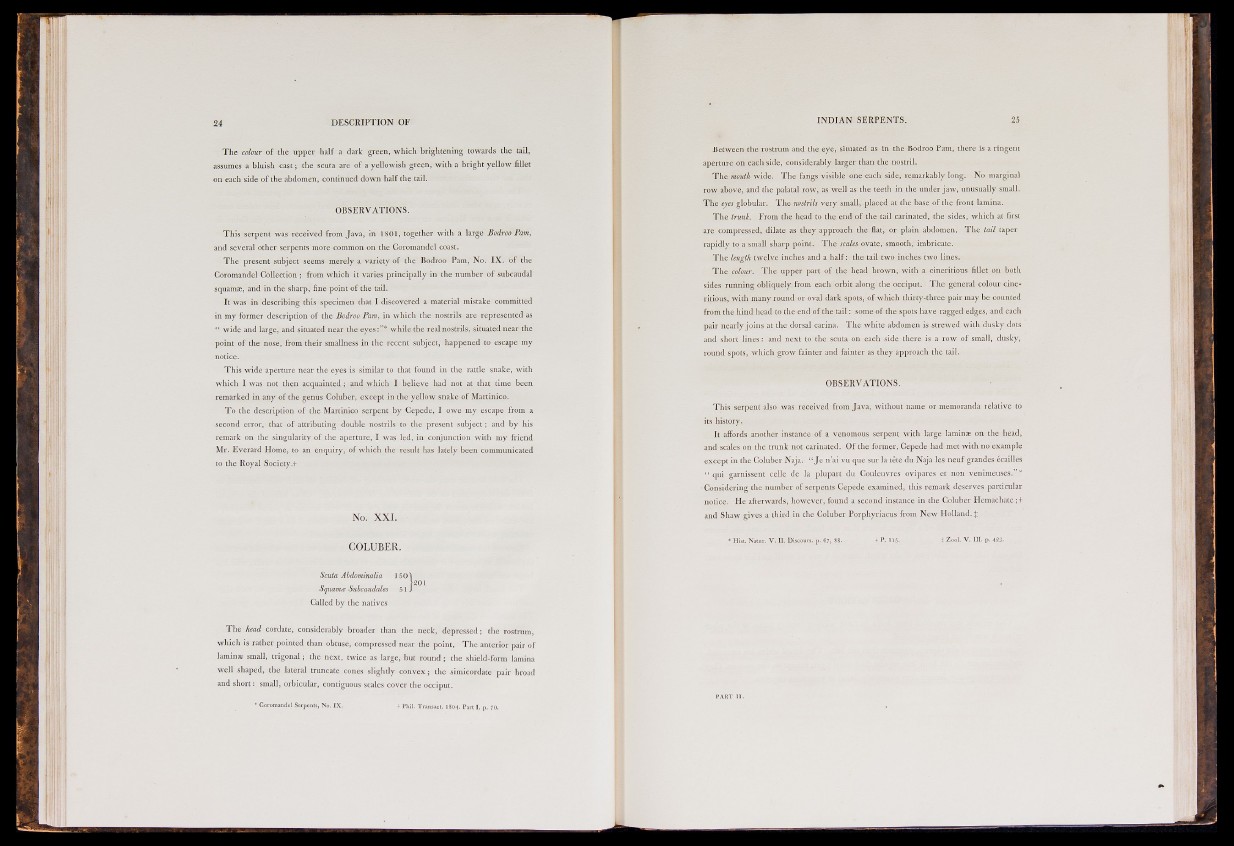
2 4 DESCRIPTION OF
The colour of the upper half a dark green, which brightening towards the tail,
assumes a bluish cast; the scuta are of a yellowish green, with a bright yellow fillet
on each side of the abdomen, continued down half the tail.
OBSERVATIONS.
This serpent was received from Java, in 1801, together with a large Bodroo Pam,
and several other serpents more common on the Coromandel coast.
The present subject seems merely a variety of the Bodroo Pam, No. IX. of the
Coromandel Collection ; from which it varies principally in the number of subcaudal
squamae, and in the sharp, fine point of the tail.
It was in describing this specimen that I discovered a material mistake committed
in my former description of tlie Bodroo Pam, in which the nostrils are represented as
" wide and large, and situated near the eyes:"* while the real nostrils, situated near the
point of the nose, from their smallness in the recent subject, happened to escape my
notice.
This wide aperture near the eyes is similar to that found in the rattle snake, with
which I was not then acquainted ; and which I believe had not at that time been
remarked in any of the genus Coluber, except in the yellow snake of Martinico.
T o the description of the Martinico serpent by Cepede, I owe my escape from a
second error, that of attributing double nostrils to the present subject ; and by his
remark on the singularity of the aperture, I was led, in conjunction with my friend
Mr. Everard Home, to an enquiry, of which the result has lately been communicated
to the Royal Society.+
No. XXI.
COLUBER.
Scuta Abdominalia 150"!
Squama Subcaudales 51J
Called by the natives
The head cordate, considerably broader than the neck, depressed ; the rostrum,
whicli is rather pointed than obtuse, compressed near the point. The anterior j)air of
lamina; small, trigonal; the next, twice as large, but round ; the shield-form lamina
well shaped, the lateral truncate cones slightly convex; the simicordate pair broad
and short: small, orbicular, contiguous scales cover the occiput.
* Coromandel Serpents, No. IX. I. Part I. p. 70.
INDIAN SERPENTS. 25
Between the rostrum and the eye, situated as in the Bodroo Pam, there is a ringent
aperture on each side, considerably larger than the nostril.
The mouth wide. The fangs visible one each side, remarkably long. No marginal
row above, and the palatal row, as well as the teeth in the under jaw, unusually small.
The eyes globular. The nostrils very small, placed at the base of the front lamina.
The trunk. From the head to the end of the tail carinated, the sides, which at first
are compressed, dilate as they approach the flat, or plain abdomen. The tail taper
rapidly to a small sharp point. The scales ovate, smooth, imbricate.
The length twelve inches and a half: the tail two inches two lines.
The colour. The upper part of the head brown, with a cineritious fillet on both
sides running obliquely from each orbit along the occiput. The general colour cineritious,
with many round or oval dark spots, of which thirty-three pair may be counted
from the hind head to the end of the tail: some of the spots have ragged edges, and each
pair nearly joins at the dorsal carina. The white abdomen is strewed with dusky dots
and short lines : and next to the scuta on each side there is a row of small, dusky,
round spots, which grow fainter and fainter as they approach the tail.
OBSERVATIONS.
This serpent also was received from Java, without name or memoranda relative to
its history.
It affords another instance of a venomous serpent with large laminae on the head,
and scales on the trunk not carinated. Of the former, Cepede had met with no example
except in the Coluber Naja. " J e n'ai vu que sur la tête du Naja les neuf grandes écailles
" qui garnissent celle de la plupart du Couleuvres ovipares et non venimeuses."''
Considering the number of serpents Cepede examined, this remark deserves particular
notice. He afterwards, however, found a second instance in the Coluber Hemachate; +
and Shaw gives a third in the Coluber Porphyriacus from New Holland. J
• Hist. N;itiir. V. n. Disc s. p. 67, SS. + P. 115- í Zool, V. III. p. 423.